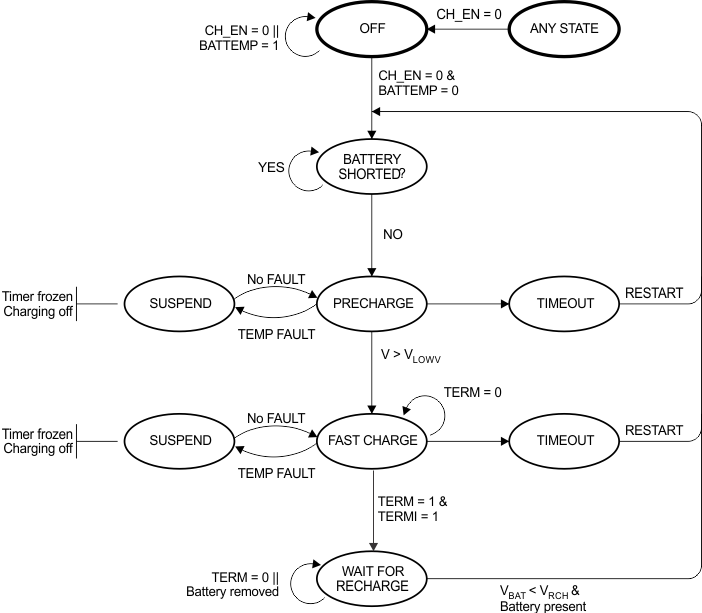ZHCSJX9 June 2019 TPS652170
PRODUCTION DATA.
- 1 特性
- 2 应用
- 3 说明
- 4 修订历史记录
- 5 Pin Configuration and Functions
- 6 Specifications
-
7 Detailed Description
- 7.1 Overview
- 7.2 Functional Block Diagram
- 7.3
Feature Description
- 7.3.1 Wake-Up and Power-Up Sequencing
- 7.3.2 Power Good
- 7.3.3 Push-Button Monitor (PB_IN)
- 7.3.4 nWAKEUP Pin (nWAKEUP)
- 7.3.5 Power Enable Pin (PWR_EN)
- 7.3.6 Reset Pin (nRESET)
- 7.3.7 Interrupt Pin (nINT)
- 7.3.8 Analog Multiplexer
- 7.3.9 Battery Charger and Power Path
- 7.3.10 Battery Charging
- 7.3.11 Precharge
- 7.3.12 Charge Termination
- 7.3.13 Battery Detection and Recharge
- 7.3.14 Safety Timer
- 7.3.15 Battery-Pack Temperature Monitoring
- 7.3.16 DC/DC Converters
- 7.3.17 Standby LDO Regulators (LDO1, LDO2)
- 7.3.18 Load Switches or LDO Regulators (LS1 or LDO3, LS2 or LDO4)
- 7.3.19 White LED Driver
- 7.4 Device Functional Modes
- 7.5 Programming
- 7.6
Register Maps
- 7.6.1 Register Address Map
- 7.6.2 Chip ID Register (CHIPID) (Address = 0x00) [reset = 0x02]
- 7.6.3 Power Path Control Register (PPATH) (Address = 0x01) [reset = 0x3D]
- 7.6.4 Interrupt Register (INT) (Address = 0x02) [reset = 0x80]
- 7.6.5 Charger Configuration Register 0 (CHGCONFIG0) (Address = 0x03) [reset = 0x00]
- 7.6.6 Charger Configuration Register 1 (CHGCONFIG1) (Address = 0x04) [reset = 0xB1]
- 7.6.7 Charger Configuration Register 2 (CHGCONFIG2) (Address = 0x05) [reset = 0x80]
- 7.6.8 Charger Configuration Register 3 (CHGCONFIG3) (Address = 0x06) [reset = 0xB2]
- 7.6.9 WLED Control Register 1 (WLEDCTRL1) (Address = 0x07) [reset = 0xB1]
- 7.6.10 WLED Control Register 2 (WLEDCTRL2) (Address = 0x08) [reset = 0x00]
- 7.6.11 MUX Control Register (MUXCTRL) (Address = 0x09) [reset = 0x00]
- 7.6.12 Status Register (STATUS) (Address = 0x0A) [reset = 0x00]
- 7.6.13 Password Register (PASSWORD) (Address = 0x0B) [reset = 0x00]
- 7.6.14 Power Good Register (PGOOD) (Address = 0x0C) [reset = 0x00]
- 7.6.15 Power-Good Control Register (DEFPG) (Address = 0x0D) [reset = 0x0C]
- 7.6.16 DCDC1 Control Register (DEFDCDC1) (Address = 0x0E) [reset = 0x18]
- 7.6.17 DCDC2 Control Register (DEFDCDC2) (Address = 0x0F) [reset = 0x08]
- 7.6.18 DCDC3 Control Register (DEFDCDC3) (Address = 0x10) [reset = 0x08]
- 7.6.19 Slew-Rate Control Register (DEFSLEW) (Address = 0x11) [reset = 0x06]
- 7.6.20 LDO1 Control Register (DEFLDO1) (Address = 0x12) [reset = 0x09]
- 7.6.21 LDO2 Control Register (DEFLDO2) (Address = 0x13) [reset = 0x38]
- 7.6.22 Load Switch1 or LDO3 Control Register (DEFLS1) (Address = 0x14) [reset = 0x26]
- 7.6.23 Load Switch2 or LDO4 Control Register (DEFLS2) (Address = 0x15) [reset = 0x3F]
- 7.6.24 Enable Register (ENABLE) (Address = 0x16) [reset = 0x00]
- 7.6.25 UVLO Control Register (DEFUVLO) (Address = 0x18) [reset = 0x00]
- 7.6.26 Sequencer Register 1 (SEQ1) (Address = 0x19) [reset = 0x00]
- 7.6.27 Sequencer Register 2 (SEQ2) (Address = 0x1A) [reset = 0x00]
- 7.6.28 Sequencer Register 3 (SEQ3) (Address = 0x1B) [reset = 0x00]
- 7.6.29 Sequencer Register 4 (SEQ4) (Address = 0x1C) [reset = 0x40]
- 7.6.30 Sequencer Register 5 (SEQ5) (Address = 0x1D) [reset = 0x20]
- 7.6.31 Sequencer Register 6 (SEQ6) (Address = 0x1E) [reset = 0x00]
- 8 Application and Implementation
- 9 Power Supply Recommendations
- 10Layout
- 11器件和文档支持
- 12机械、封装和可订购信息
封装选项
请参考 PDF 数据表获取器件具体的封装图。
机械数据 (封装 | 引脚)
- RSL|48
散热焊盘机械数据 (封装 | 引脚)
- RSL|48
订购信息
7.3.14.2 Timer Fault
A timer fault occurs if the battery voltage does not exceed the VLOWV voltage in the tPRECHG time during precharging. A timer fault also occurs if the battery current does not reach the ITERM current in fast charge before the safety timer expires. Fast-charge time is measured from the start of the fast-charge cycle.
The fault status is indicated by the CHTOUT and PCHTOUT bits in the CHGCONFIG0 register. Time-out faults are cleared and a new charge cycle is started when either the USB or AC supply is connected (rising edge of VUSB or VAC), the charger RESET bit is set to 1b in the CHGCONFIG1 register, or the battery voltage decreases to less than the recharge threshold (VRCH).
